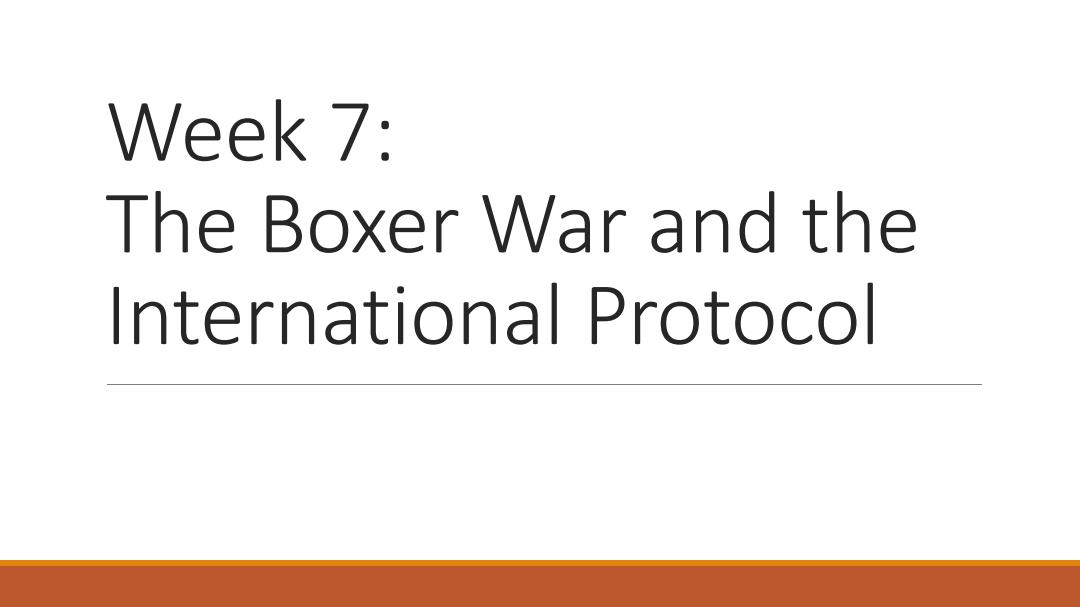
Week 7: The boxer War and the International Protocol
Week 7: The Boxer War and the International Protocol
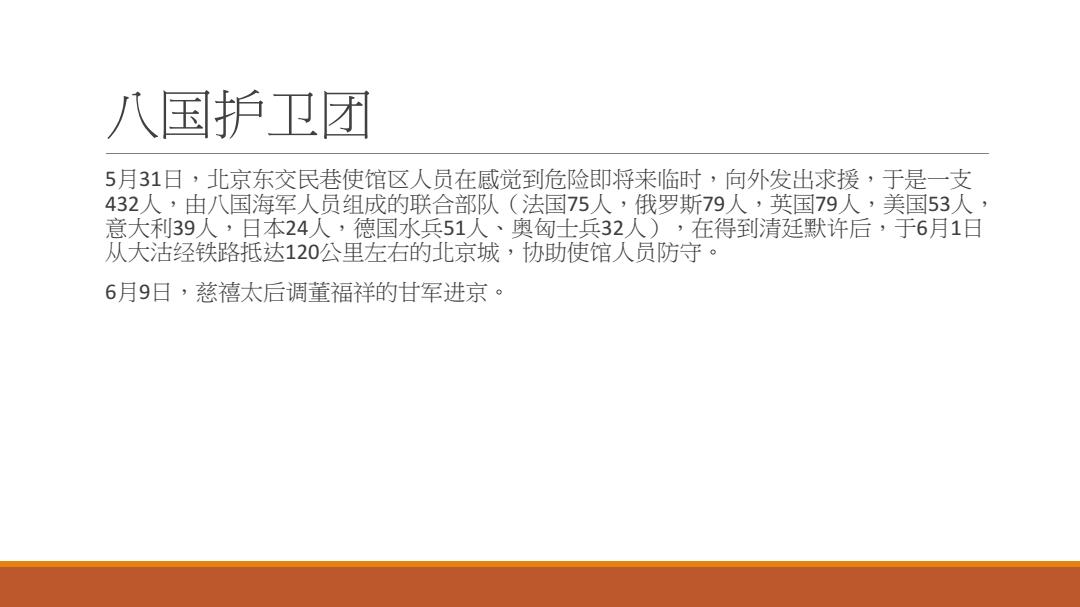
八国护卫团 5月31日,北京东交民巷使馆区人员在咸觉到危险即将来临时,向外发出求援,于是一支 432人·由八国海军人员组成的联合部队(法国75人,俄罗斯79人,英国79人,美国53人, 意大利39人,日本24人,德国水兵51人、奥匈士兵32人),在得到清廷默许后,于6月1日 从大沽经铁路抵达120公里左右的北京城,协助使馆人员防守。 6月9日,慈禧太后调董福祥的甘军进京
八国护卫团 5月31日,北京东交民巷使馆区人员在感觉到危险即将来临时,向外发出求援,于是一支 432人,由八国海军人员组成的联合部队(法国75人,俄罗斯79人,英国79人,美国53人, 意大利39人,日本24人,德国水兵51人、奥匈士兵32人),在得到清廷默许后,于6月1日 从大沽经铁路抵达120公里左右的北京城,协助使馆人员防守。 6月9日,慈禧太后调董福祥的甘军进京
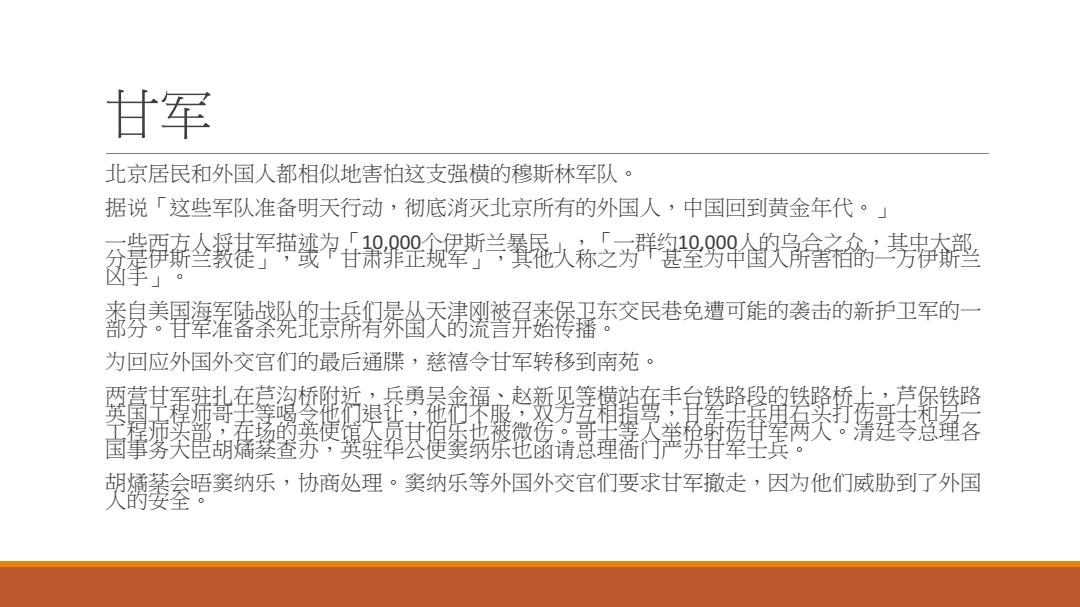
甘军 北京居民和外国人都相似地害怕这支强横的穆斯林军队。 据说「这些军队准备明天行动,彻底消灭北京所有的外国人,中国回到黄金年代。」 一些西方人舟甘军描述为「1Q,Q00个伊斯兰暴民 分是伊斯坐教徒中,践 甘肃非罡规军花久称之为 称之为群9帆备是 ☒手」 来自美国海军陟战队的士但是丛天津刚被系来堡卫东交民巷免遭可能的袭击的新护卫军的一 部分。甘军准备系死北京所有外国人的流言开始传播· 为回应外国外交官们的最后通牒,慈禧令甘军转移到南苑。 蒿甘军驻扎在惹沟桥附近,兵勇吴金福、赵新见等模站在丰 铁路段的铁路桥,上芦保铁路 英 玉 ▣、 士喝 为 用君 于堂病父。着是杏点弹各 寸」力 部在场的英使馆公宽甘出楼微伤哥 举径射 国事务臣胡,案香苏,英驻準公便窦纲紧也函请总蓓 “办甘军士兵 胡燏茶会晤窦纳乐,协商处理。窦纳乐等外国外交官们要求甘军撤走,因为他们威胁到了外国 人的安全
甘军 北京居民和外国人都相似地害怕这支强横的穆斯林军队。 据说「这些军队准备明天行动,彻底消灭北京所有的外国人,中国回到黄金年代。」 一些西方人将甘军描述为「10,000个伊斯兰暴民」,「一群约10,000人的乌合之众,其中大部 分是伊斯兰教徒」,或「甘肃非正规军」,其他人称之为「甚至为中国人所害怕的一万伊斯兰 凶手」。 来自美国海军陆战队的士兵们是从天津刚被召来保卫东交民巷免遭可能的袭击的新护卫军的一 部分。甘军准备杀死北京所有外国人的流言开始传播。 为回应外国外交官们的最后通牒,慈禧令甘军转移到南苑。 两营甘军驻扎在芦沟桥附近,兵勇吴金福、赵新见等横站在丰台铁路段的铁路桥上,芦保铁路 英国工程师哥士等喝令他们退让,他们不服,双方互相指骂,甘军士兵用石头打伤哥士和另一 工程师头部,在场的英使馆人员甘伯乐也被微伤。哥士等人举枪射伤甘军两人。清廷令总理各 国事务大臣胡燏棻查办,英驻华公使窦纳乐也函请总理衙门严办甘军士兵。 胡燏棻会晤窦纳乐,协商处理。窦纳乐等外国外交官们要求甘军撤走,因为他们威胁到了外国 人的安全
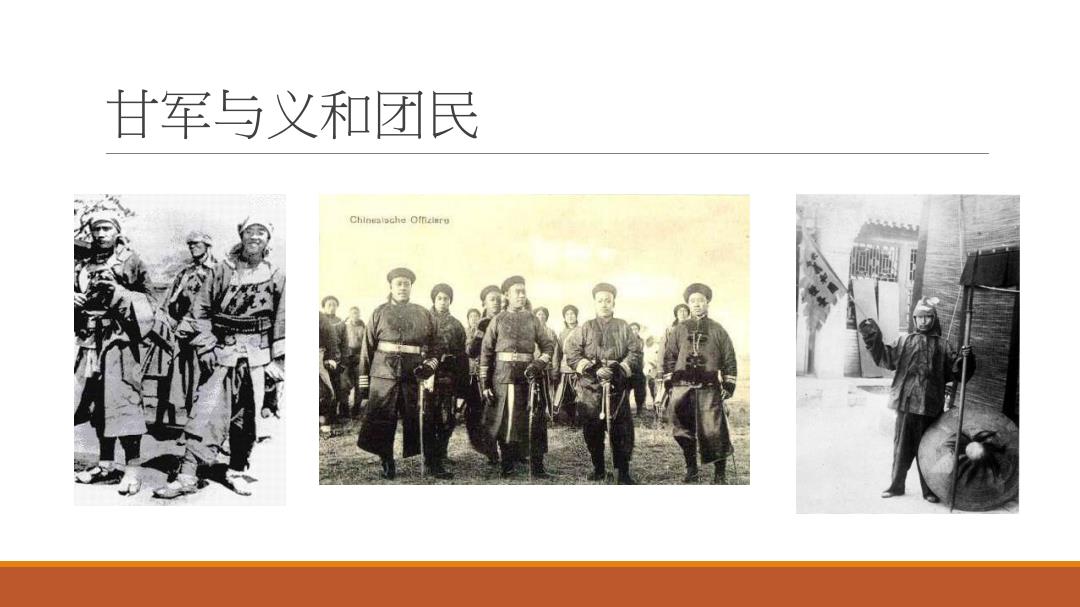
甘军与义和团民 Chletaloche Offainru
甘军与义和团民
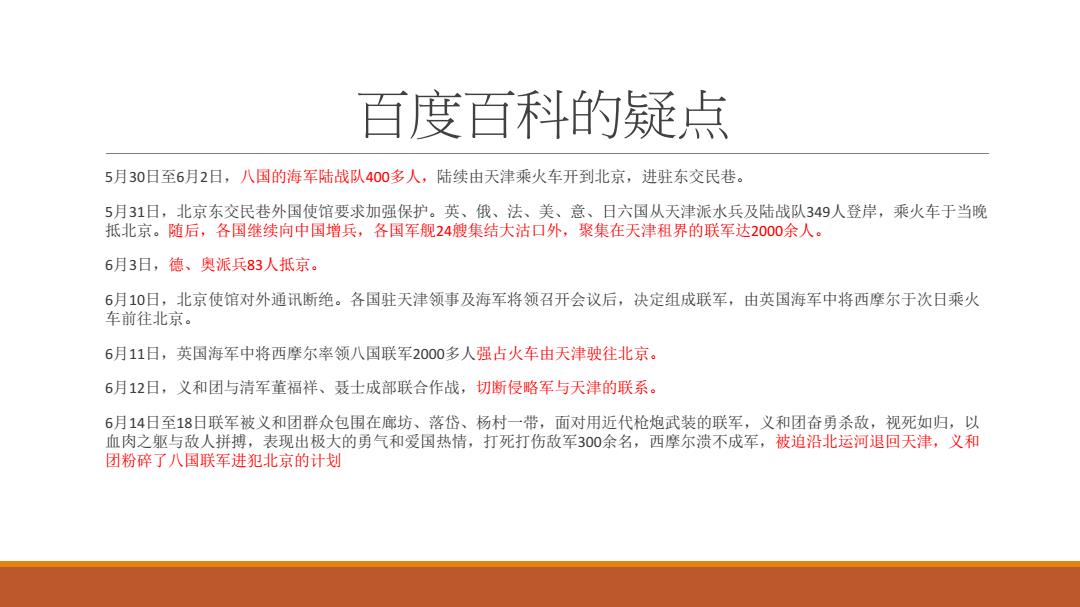
百度百科的疑点 5月30日至6月2日,八国的海军陆战队400多人,陆续由天津乘火车开到北京,进驻东交民巷。 5月31日,北京东交民巷外国使馆要求加强保护。英、俄、法、美、意、日六国从天津派水兵及陆战队349人登岸,乘火车于当晚 抵北京。随后,各国继续向中国增兵,各国军舰24艘集结大沽口外,聚集在天津租界的联军达2000余人。 6月3日,德、奥派兵83人抵京。 6月10日,北京使馆对外通讯断绝。各国驻天津领事及海军将领召开会议后,决定组成联军,由英国海军中将西摩尔于次日乘火 车前往北京。 6月11日,英国海军中将西摩尔率领八国联军2000多人强占火车由天津驶往北京。 6月12日,义和团与清军董福祥、聂士成部联合作战,切断侵略军与天津的联系。 6月14日至18日联军被义和团群众包围在廊坊、落岱、杨村一带,面对用近代枪炮武装的联军,义和团奋勇杀敌,视死如归,以 血肉之躯与敌人拼搏,表现出极大的勇气和爱国热情,打死打伤敌军300余名,西摩尔溃不成军,被迫沿北运河退回天津,义和 团粉碎了八国联军进犯北京的计划
百度百科的疑点 5月30日至6月2日,八国的海军陆战队400多人,陆续由天津乘火车开到北京,进驻东交民巷。 5月31日,北京东交民巷外国使馆要求加强保护。英、俄、法、美、意、日六国从天津派水兵及陆战队349人登岸,乘火车于当晚 抵北京。随后,各国继续向中国增兵,各国军舰24艘集结大沽口外,聚集在天津租界的联军达2000余人。 6月3日,德、奥派兵83人抵京。 6月10日,北京使馆对外通讯断绝。各国驻天津领事及海军将领召开会议后,决定组成联军,由英国海军中将西摩尔于次日乘火 车前往北京。 6月11日,英国海军中将西摩尔率领八国联军2000多人强占火车由天津驶往北京。 6月12日,义和团与清军董福祥、聂士成部联合作战,切断侵略军与天津的联系。 6月14日至18日联军被义和团群众包围在廊坊、落岱、杨村一带,面对用近代枪炮武装的联军,义和团奋勇杀敌,视死如归,以 血肉之躯与敌人拼搏,表现出极大的勇气和爱国热情,打死打伤敌军300余名,西摩尔溃不成军,被迫沿北运河退回天津,义和 团粉碎了八国联军进犯北京的计划
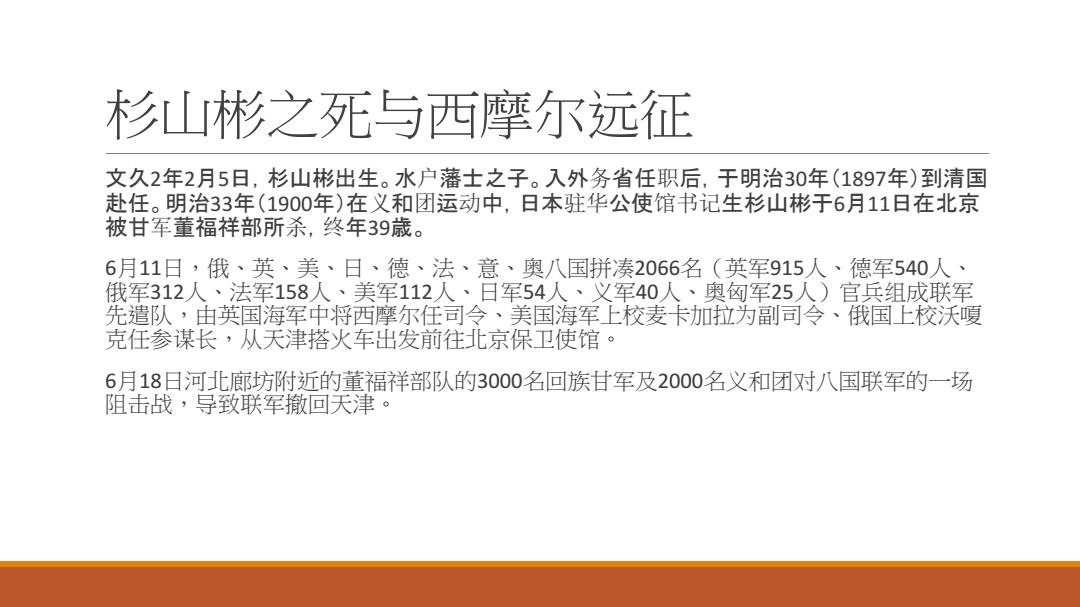
杉山彬之死与西摩尔远征 文久2年2月5日,杉山彬出生。水户藩士之子。入外务省任职后,于明治30年(1897年)到清国 赴任。明治33年(1900年)在义和团运动中,日本驻华公使馆书记生杉山彬于6月11日在北京 被甘军董福祥部所杀,终年39歳。 6月11日,俄、英、美、日、德、法、意、奥八国拼凑2066名(英军915人、德军540人、 俄军312人、法军158人、美军112人、日军54人、义军40人、奥匈军25人)官兵组成联军 先遣队,由英国海军中将西摩尔任司令、美国海军上校麦卡加拉为副司令、俄国上校沃嗄 克任参谋长,从天津搭火车出发前往北京保卫使馆。 6月18日河北廊坊附近的董福祥部队的3000名回族甘军及2000名义和团对八国联军的一场 阻击战,导致联军撤回天津
杉山彬之死与西摩尔远征 文久2年2月5日,杉山彬出生。水户藩士之子。入外务省任职后,于明治30年(1897年)到清国 赴任。明治33年(1900年)在义和团运动中,日本驻华公使馆书记生杉山彬于6月11日在北京 被甘军董福祥部所杀,终年39歳。 6月11日,俄、英、美、日、德、法、意、奥八国拼凑2066名(英军915人、德军540人、 俄军312人、法军158人、美军112人、日军54人、义军40人、奥匈军25人)官兵组成联军 先遣队,由英国海军中将西摩尔任司令、美国海军上校麦卡加拉为副司令、俄国上校沃嗄 克任参谋长,从天津搭火车出发前往北京保卫使馆。 6月18日河北廊坊附近的董福祥部队的3000名回族甘军及2000名义和团对八国联军的一场 阻击战,导致联军撤回天津
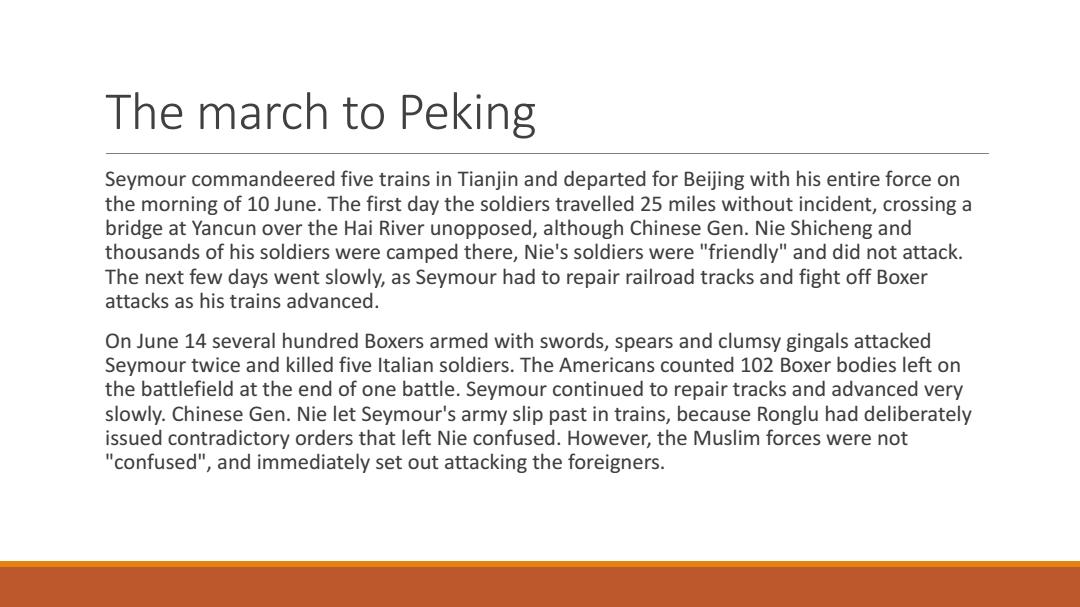
The march to Peking Seymour commandeered five trains in Tianjin and departed for Beijing with his entire force on the morning of 10 June.The first day the soldiers travelled 25 miles without incident,crossing a bridge at Yancun over the Hai River unopposed,although Chinese Gen.Nie Shicheng and thousands of his soldiers were camped there,Nie's soldiers were "friendly"and did not attack. The next few days went slowly,as Seymour had to repair railroad tracks and fight off Boxer attacks as his trains advanced. On June 14 several hundred Boxers armed with swords,spears and clumsy gingals attacked Seymour twice and killed five Italian soldiers.The Americans counted 102 Boxer bodies left on the battlefield at the end of one battle.Seymour continued to repair tracks and advanced very slowly.Chinese Gen.Nie let Seymour's army slip past in trains,because Ronglu had deliberately issued contradictory orders that left Nie confused.However,the Muslim forces were not "confused",and immediately set out attacking the foreigners
The march to Peking Seymour commandeered five trains in Tianjin and departed for Beijing with his entire force on the morning of 10 June. The first day the soldiers travelled 25 miles without incident, crossing a bridge at Yancun over the Hai River unopposed, although Chinese Gen. Nie Shicheng and thousands of his soldiers were camped there, Nie's soldiers were "friendly" and did not attack. The next few days went slowly, as Seymour had to repair railroad tracks and fight off Boxer attacks as his trains advanced. On June 14 several hundred Boxers armed with swords, spears and clumsy gingals attacked Seymour twice and killed five Italian soldiers. The Americans counted 102 Boxer bodies left on the battlefield at the end of one battle. Seymour continued to repair tracks and advanced very slowly. Chinese Gen. Nie let Seymour's army slip past in trains, because Ronglu had deliberately issued contradictory orders that left Nie confused. However, the Muslim forces were not "confused" , and immediately set out attacking the foreigners
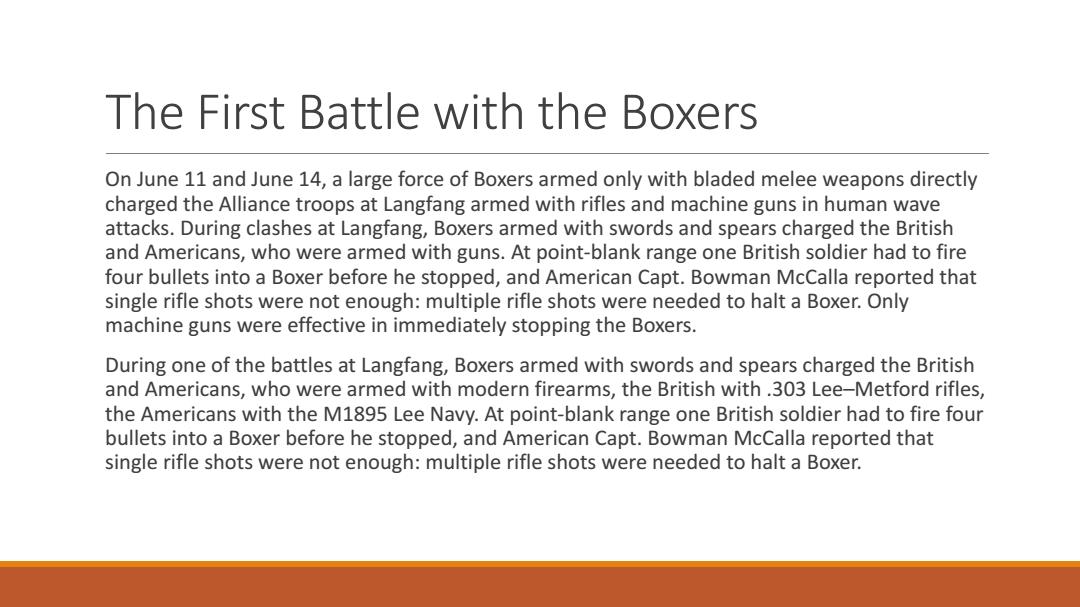
The First Battle with the Boxers On June 11 and June 14,a large force of Boxers armed only with bladed melee weapons directly charged the Alliance troops at Langfang armed with rifles and machine guns in human wave attacks.During clashes at Langfang,Boxers armed with swords and spears charged the British and Americans,who were armed with guns.At point-blank range one British soldier had to fire four bullets into a Boxer before he stopped,and American Capt.Bowman McCalla reported that single rifle shots were not enough:multiple rifle shots were needed to halt a Boxer.Only machine guns were effective in immediately stopping the Boxers. During one of the battles at Langfang,Boxers armed with swords and spears charged the British and Americans,who were armed with modern firearms,the British with.303 Lee-Metford rifles, the Americans with the M1895 Lee Navy.At point-blank range one British soldier had to fire four bullets into a Boxer before he stopped,and American Capt.Bowman McCalla reported that single rifle shots were not enough:multiple rifle shots were needed to halt a Boxer
The First Battle with the Boxers On June 11 and June 14, a large force of Boxers armed only with bladed melee weapons directly charged the Alliance troops at Langfang armed with rifles and machine guns in human wave attacks. During clashes at Langfang, Boxers armed with swords and spears charged the British and Americans, who were armed with guns. At point-blank range one British soldier had to fire four bullets into a Boxer before he stopped, and American Capt. Bowman McCalla reported that single rifle shots were not enough: multiple rifle shots were needed to halt a Boxer. Only machine guns were effective in immediately stopping the Boxers. During one of the battles at Langfang, Boxers armed with swords and spears charged the British and Americans, who were armed with modern firearms, the British with .303 Lee–Metford rifles, the Americans with the M1895 Lee Navy. At point-blank range one British soldier had to fire four bullets into a Boxer before he stopped, and American Capt. Bowman McCalla reported that single rifle shots were not enough: multiple rifle shots were needed to halt a Boxer

The Battle of Langfang On June 18,1900,Dong Fuxiang's troops,stationed at Hunting Park in southern Beijing,attacked at multiple points including LangFang.The forces included 5,000 cavalrymen,armed with modern rifles.They led a force of Hui Muslims,Dongxiang Muslims,and Baoan Muslims in the ambush at Langfang with Ma Fulu personally leading a cavalry charge,cutting down enemy troops with his sword. The Boxers and Dong Fuxiang's army worked together in the joint ambush with the Boxers relentlessly assaulting the Allies head on with human wave attacks displaying "no fear of death"and engaging the Allies in melee combat and putting the Allied troops under severe mental stress by mimicking vigorous gunfire with firecrackers. The Allies however suffered most of their losses at the hands of General Dong's troops,who used their expertise and persistence to engage in "bold and persistent"assaults on the Alliance forces,as remembered by the German Captain Usedom and the right wing of the Germans was almost at the point of collapse under the attack until they were rescued from Langfang by French and British troops,and the Allies then retreated from Langfang in trains full of bullet holes.The foreign troops,especially the Germans,fought off the attack,killing 400 at a loss of seven dead and 57 wounded.The Kansu Braves lost 200 and the Boxers another 200. The Boxers directly and relentlessly charged the allies during the attack,which unnerved them.The need to care for the wounded,a lack of supplies and the likelihood of additional Chinese attacks resulted in Seymour and his officers deciding to retreat to Tientsin
The Battle of Langfang On June 18, 1900, Dong Fuxiang's troops, stationed at Hunting Park in southern Beijing, attacked at multiple points including LangFang. The forces included 5,000 cavalrymen, armed with modern rifles. They led a force of Hui Muslims, Dongxiang Muslims, and Baoan Muslims in the ambush at Langfang with Ma Fulu personally leading a cavalry charge, cutting down enemy troops with his sword. The Boxers and Dong Fuxiang's army worked together in the joint ambush with the Boxers relentlessly assaulting the Allies head on with human wave attacks displaying "no fear of death" and engaging the Allies in melee combat and putting the Allied troops under severe mental stress by mimicking vigorous gunfire with firecrackers. The Allies however suffered most of their losses at the hands of General Dong's troops, who used their expertise and persistence to engage in "bold and persistent" assaults on the Alliance forces, as remembered by the German Captain Usedom and the right wing of the Germans was almost at the point of collapse under the attack until they were rescued from Langfang by French and British troops, and the Allies then retreated from Langfang in trains full of bullet holes. The foreign troops, especially the Germans, fought off the attack, killing 400 at a loss of seven dead and 57 wounded. The Kansu Braves lost 200 and the Boxers another 200. The Boxers directly and relentlessly charged the allies during the attack, which unnerved them. The need to care for the wounded, a lack of supplies and the likelihood of additional Chinese attacks resulted in Seymour and his officers deciding to retreat to Tientsin

Seymour Expedition,10-28 June,1900 PEKING ROUTE OF ADMIRAL SEYMOUR'S 0 Tung Chou Feng-t'ai EXPEDITI0NO●●oO OMachiapu Chengchiawan Lu-Han Matou /To Paoting Lang:Fana's Lofa ROUTE OF RELIEF FORCE Shan-hai-kuan Yangtsun Hun Ho River Peitsang Hsi-Ku 9● TIENTSIN T'ang-ku Taku
Seymour Expedition, 10–28 June, 1900